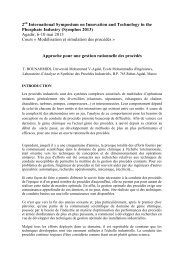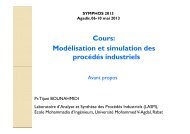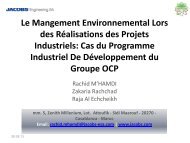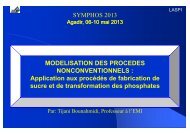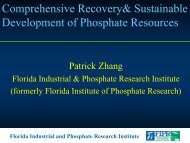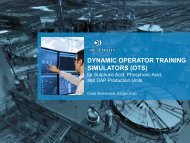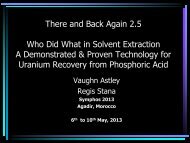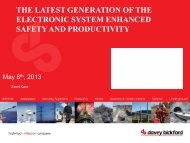Abstract SYMPHOS 2011
Abstract SYMPHOS 2011
Abstract SYMPHOS 2011
Create successful ePaper yourself
Turn your PDF publications into a flip-book with our unique Google optimized e-Paper software.
INCREASING LAND AND COMMUNITY RELATED CONFLICTS IN MINERAL<br />
EXPLOITATION- CASE STUDIES FROM INDIA<br />
P17<br />
Jayanta Bhattacharya,<br />
Professor ,Department of Mining Engineering, Indian Institute of Technology,<br />
Kharagpur, INDIA,<br />
Honorary Advisor of Environmental and Social Performance, Tata Steel<br />
In the post independence India, the recent land and community conflicts are emerging as great challenges ahead<br />
of technology and project finance. Land and community related conflicts are on the rise in populous and land short<br />
emerging economies of India where rehabilitation and resettlement schemes by the government and the corporate<br />
in the mining areas are bringing in mixed results.<br />
Poor knowledge of mining and mineral engineers about the aspects of land holdings, politics and little knowledge<br />
of local culture of the settled and tribal communities are bringing in industrial hurdles and great economic loss.<br />
The paper describes the issues and case studies of similar events in India and the preparedness of the corporate to<br />
handle the crisis.<br />
118<br />
ENERGY MANAGEMENT IN THE PHOSPHATE INDUSTRY<br />
Messaoudi Brahim<br />
Business & Technologies International,<br />
30, rue Oum Rabi. Res. Oum Rabi II. Apt. N_ 1. Agdal-Rabat, MOROCCO<br />
P18<br />
Energy management in the phosphate industry is very important; especially in the sulfuric acid plant, as it is the<br />
main source of energy for the production of both intermediate and final products. In this context, and for the<br />
sake of rational and efficient usage of available energy sources, it has been decided to assess the impact of «Pinch<br />
Analysis» and «Process Integration» on a DAP production process, and deduce some useful conclusions with<br />
regard to its application to this kind of industry.<br />
Process integration includes a number of techniques that allow engineers to evaluate entire processes or<br />
sites, rather than focusing on individual unit operations. This includes hierarchical design methods, knowledgebased<br />
systems, numerical and graphical techniques and pinch analysis. However, in the area of energy efficiency,<br />
which is the primary focus of this work, pinch methods are dominant, but are often interchangeable with “process<br />
integration (PI)” in this field.<br />
The first phase of this analysis employed pinch targeting within an existing fertilizers plant, a methodology for<br />
identifying energy-cost reduction potential based on the thermodynamic characteristics of a process. The second<br />
phase consists of identifying potential solutions corresponding to opportunities identified during the assessment.<br />
This assessment involved mainly the production area of the plant related to sulfuric acid production. Several<br />
opportunities for energy use reduction were identified, and related annual savings resulting from any eventual<br />
energy conservation project have been evaluated.






